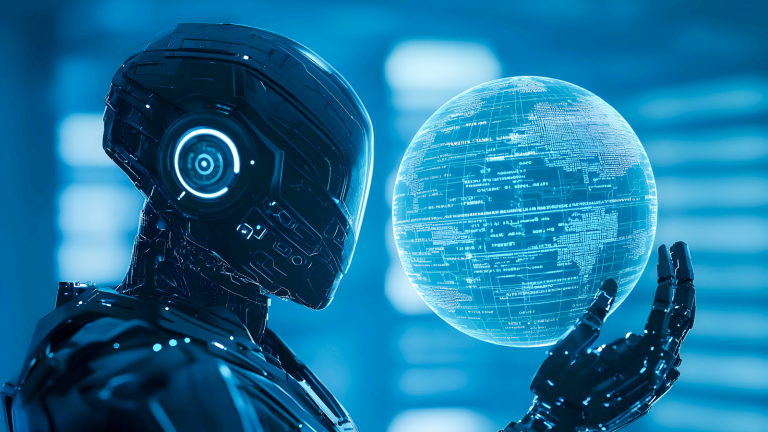The most important technology shifts happen when no one’s looking.
While the world was busy debating whether robots would steal jobs, innovation continued in the quiet corners of global industry: robots stopped being machines and started becoming minds.
Over 4.2 million robots now operate in factories worldwide – a 10% jump in just one year, according to the International Federation of Robotics. The AI robotics market is exploding from $12.77 billion in 2023 to a projected $124.77 billion by 2030… a 38% annual growth rate that dwarfs most tech sectors.
And these aren’t the clunky, pre-programmed factory arms of decades past. Today’s robots coordinate across cities, make split-second decisions, and learn from every interaction. Waymo delivers 250,000 autonomous rides weekly. Amazon (AMZN) employs over a million warehouse robots. Tesla‘s (TSLA) humanoids are training in real factories.
The question isn’t whether we noticed they already arrived. It’s whether we understand the economic earthquake they’re about to trigger…
We’re looking at addressable markets measured not in billions but in trillions. The digitization of labor itself could be the biggest economic transformation of the 21st century.
This is AI’s next chapter. And according to none other than Nvidia (NVDA) CEO Jensen Huang – the architect behind the first wave of AI riches – it will be even more impactful.
He calls it Physical AI: embodied intelligence that thinks and acts.
And this revolution is unfolding in three distinct waves that are reshaping trillion-dollar industries right now…
The Massive Market Opportunity for Robotics Across Industries
The addressable market for Physical AI is on a scale unlike most anything we’ve yet seen.
Let’s break it down.
- Self-Driving Cars: The global automotive market currently measures over $3 trillion. And as for ride-hailing, it’s already a $200 billion industry on its way to $500 billion in gross volume. That means that whoever owns the robotaxis owns a transportation goldmine.
- Warehouse Automation: There are over 5 million warehouses worldwide, many still only partially automated. As the push for efficiency accelerates, automation in logistics and fulfillment could eventually unlock a $300- to $500-billion opportunity across robotics, software, and AI systems.
- Restaurant Robots: The global restaurant industry spends over $1.2 trillion a year on labor alone. Robotic cooking, serving, and cleaning technologies are increasingly poised to cut those costs and boost margins, especially in fast food and hospitality, where automation is gaining traction.
- Consumer Humanoids: If just 5% of the world’s 2 billion households were to buy a $20,000 robot in the next decade, that would represent a $2-trillion addressable market. Raise the adoption or the price point, and suddenly, you’re looking at a potential $10 trillion opportunity.
The digitization of labor itself could just be the biggest economic transformation of the 21st century.
And we believe this revolution will unfold in three distinct waves.
Wave 1: AI-Driven Self‑Driving Cars Hit the Streets
The first has already hit the road – literally – with self-driving cars.
Alphabet’s (GOOGL) Waymo is quietly running one of the most advanced robotaxi networks in the world, delivering over 250,000 autonomous rides per week in cities like Phoenix, San Francisco, Los Angeles, and Atlanta. It’s also applying to operate in New York City and mapping Tokyo. This is beyond testing; we’ve arrived at widespread deployment.
Tesla, meanwhile, just launched its own robotaxi service in Austin. Rides cost as little as $4.20. The cars drive themselves (alongside safety drivers for now), marking the start of Tesla’s bold plan to scale a fully autonomous taxi network powered by its existing fleet and its coming Cybercab vehicle.
Then there’s Amazon-backed Zoox, which is preparing for a major launch in Las Vegas later this year. Its custom-designed, bidirectional pod is built from the ground up for autonomous city driving. Production capacity currently measures 10,000 units per year. And that’s just the beginning.
Uber (UBER) has been busy here, too. It’s teamed up with Waymo in multiple cities and is now partnering with Volkswagen to deploy a new robotaxi fleet in LA. Uber doesn’t want to build the tech; it wants to aggregate autonomous providers. Waymo, VW – it just keeps adding names.
The robotaxi race has clearly begun. And it’s just the opening salvo of Physical AI…
Wave 2: Warehouse Robots – The Hidden Backbone of Logistics
While robotaxis grab headlines, the second wave of Physical AI is already hard at work transforming the global supply chain.
- Amazon now has more than 1 million of the machines working in its warehouses today, picking, sorting, packing, and transporting products with increasing autonomy. Soon, the company will employ as many robots as it does humans.
- FedEx (FDX) is using robots to load and unload trucks, moving goods through logistics centers with minimal human involvement.
- Walmart (WMT) has partnered with Symbotic (SYM) to fully automate all 42 of its regional distribution centers – a massive shift that could reshape retail logistics across the U.S.
This industrial shift has been taking place behind the scenes for several years. And we’ve now arrived at a point when warehouse jobs are being absorbed by Physical AI at scale. It’s faster, safer – and can be more reliable, as it never needs a break, sick leave, or paid time off.
And alongside this technological takeover, the suppliers creating bots’ vital components are enjoying heightened demand. Those producing the sensors, chips, robotic arms, and AI control stacks for these facilities are poised to become giants.
Wave 3: Humanoid Robotics Are the Next Frontier in Automation
And now we come to the final – and arguably most important – wave of Physical AI: humanoid robots…
Because once you’ve built machines that can see, reason, and move around a warehouse, the next challenge is creating bots that can move through our world. Open doors. Climb stairs. Pick up boxes. Cook dinner. Fold laundry. Carry groceries.
That’s where we’re headed now – and fast.
Tesla appears to be leading the charge here. Elon Musk has made it clear that Tesla isn’t just a car company; it’s a robotics company. Its Optimus is a full-blown humanoid, powered by Tesla’s FSD AI stack, trained in Tesla factories, and expected to launch externally as early as 2026.
Nvidia, meanwhile, has built an entire software and hardware stack for humanoid robots. Its Isaac GR00T platform trains humanoids in simulation using real-world physics, and its new Rubin and Blackwell chips are designed to power them. It’s even partnering with Foxconn to build humanoid robot factories.
Meta (META) is also building its own robot operating system. Startups like Figure and Apptronik are working with Ford (F), BMW, and logistics giants to build humanoids for factory and warehouse environments.
And over in China, robotics firm UBTech is launching a consumer-grade humanoid robot with a $20,000 price tag for families and households. That’s happening this year.
Meanwhile, just this past weekend at Tsinghua University in Beijing, China put on an entertaining display as teams of humanoid robots faced off in fully autonomous 3-on-3 soccer matches. Now, don’t get us wrong; these bots performed more like toddlers than pro athletes. But it was still a strong demonstration of current robotic agility and real-time decision-making. If they can score goals today, they can certainly sweep floors, stock shelves, or serve fries tomorrow.
This is the future. And it’s fast-approaching.
Investing Before Physical AI Goes Mainstream
The AI Boom is beginning to evolve, leaving chatbots and data centers and stepping into the real world.
Robotaxis are transporting passengers throughout cities around the world.
Warehouses are being automated, reshaping both labor and logistics along the way.
And humanoid robots will likely soon become part of everyday life for many.
We’ve arrived in the era of Physical AI. And we think this is the moment before the flood…
Because if you invest now – before CNBC runs a segment about “Why Robots Are the New Gold Rush”; before the stocks go vertical and the bots are everywhere…
You and your portfolio will be ready to capitalize on one of the largest industrial transformations of our lifetime.
Click here to learn more about some of the most promising Physical AI investments right now.


